Efficient and stable wireless power transfer based on the non-Hermitian physics
2022-01-23ChaoZeng曾超ZhiweiGuo郭志伟KejiaZhu祝可嘉CaifuFan范才富GuoLi李果JunJiang江俊YunhuiLi李云辉HaitaoJiang江海涛YapingYang羊亚平YongSun孙勇andHongChen陈鸿
Chao Zeng(曾超) Zhiwei Guo(郭志伟) Kejia Zhu(祝可嘉) Caifu Fan(范才富)Guo Li(李果)Jun Jiang(江俊) Yunhui Li(李云辉)Haitao Jiang(江海涛)Yaping Yang(羊亚平) Yong Sun(孙勇) and Hong Chen(陈鸿)
1MOE Key Laboratory of Advanced Micro-structured Materials,School of Physics Sciences and Engineering,Tongji University,Shanghai 200092,China
2Department of Electrical Engineering,Tongji University,Shanghai 201804,China
3School of Automotive Studies,Tongji University,Shanghai 210804,China
Keywords: wireless power transfer,non-Hermitian physics,topological edge states
1. Introduction
Magnetic resonance wireless power transfer(WPT)technologies proposed by Kurset al.[1]have been one of the most fascinating areas of energy transfer in recent years. The key components of such a scheme are two coupled resonance coils,where one of them provides energy input (transmitter) and the other receives energy to the load(receiver).[1]Up to now,WPT has been intensively investigated in a variety of applications such as medical implanted devices, electric vehicles,drones, portable electronic devices and so on.[2-6]However,the transfer efficiency in the system of resonance WPT is sensitive to the variation of the coupling condition. On the one hand, the strong magnetic coupling between resonance coils always leads to the splitting of working frequency, which seriously reduces the stability of the devices. On the other hand,the transfer distance strongly depends on the size of the coils.Normally,once the transfer distance is larger than the radius of the coils,the transmission efficient will decrease significantly.In order to obtain the stable and efficient energy transfer,many controlled strategies were proposed based on stability analysis of such WPT systems. For example, an impedance matching method for automatically matching the impedance between transmitter,receiver and power source is proposed. When the coupling distance changes, the reduction of the power transmission efficiency can be effectively avoided.[7,8]Another method is a working frequency tracking scheme, which can track the maximum efficiency point dynamically according to different coupling conditions.[9,10]These methods have been proved to be effective for optimizing the transferred efficiency in electric circuit.However,these circuit-based research methods have some limitations and could not provide clear physical pictures for people to understand some interesting and important phenomena in WPT system. For example, why does the transfer efficiency decrease rapidly(frequency splitting)when the transfer distance is greater (less) than the critical transfer distance and how to realize efficient long-range[11,12]or directional[13,14]energy transfer?
Very recently, the interaction between coupling (coherent effect) and gain/loss (incoherent effect) in the non-Hermitian system has shown many interesting and unexpected features.[15]In particularly, parity-time (PT) symmetry and exceptional points(EPs)associated with phase transition drawn from non-Hermitian physics have attracted considerable attention.[16-18]From the perspective of non-Hermitian photonics, the coherent and incoherent effects compete and coexist in the WPT system. Especially,it can undergo a phase transition that restores the broken symmetry. When the transfer distance is small, the coherent effect is dominant in this strong coupling region,which leads to the working frequency splitting. On the contrary,when the transfer distance is large,the WPT system corresponds to the weak coupling region(broken phase) of the non-Hermitian physical model. As a result,the transfer efficiency decreases rapidly as the transfer distance increases. Non-Hermitian physics can clearly show the limitations of the current WPT system,and provide a new way to solve the difficulties of previous designs.[3-6,19]
In this review,we mainly introduce our latest progress in resonance WPT based on non-Hermitian physics.In Section 2,based on the coupled-mode theory, we establish a bridge between open WPT system and PT symmetry in non-Hermitian system,and show that stable power transfer states correspond to the real eigenvalues of the effective Hamiltonian. The frequency splitting in the strong coupling region and the significantly reduced efficiency after passing the critical coupling point are explained clearly by the phase diagram of PT symmetry. In Section 3,we introduce that for a non-ideal secondorder PT symmetric system of the non-Hermitian physics with unbalanced effective gain and loss,there is a special state with real eigenvalue (i.e., bound state in the continuum, BIC) in the broken phase. At the fixed frequency of BIC, efficient and stable WPT can be realized. Furthermore, based on the high-order PT symmetry of non-Hermitian physics,the thirdorder PT symmetric WPT system is presented, which can be used to achieve stable and efficient WPT without frequency tracking and idle power loss remains low. In second part of Section 4, combining the edge state of a topological chain and non-Hermitian physics,the long-range WPT devices with topological properties are introduced. This topological WPT inherits the physical properties of the edge states and has good electromagnetic compatibility because it is immune to impurities and perturbations. Finally,Section 5 summarizes the conclusions of this review.
2. Non-Hermitian properties of the resonance WPT
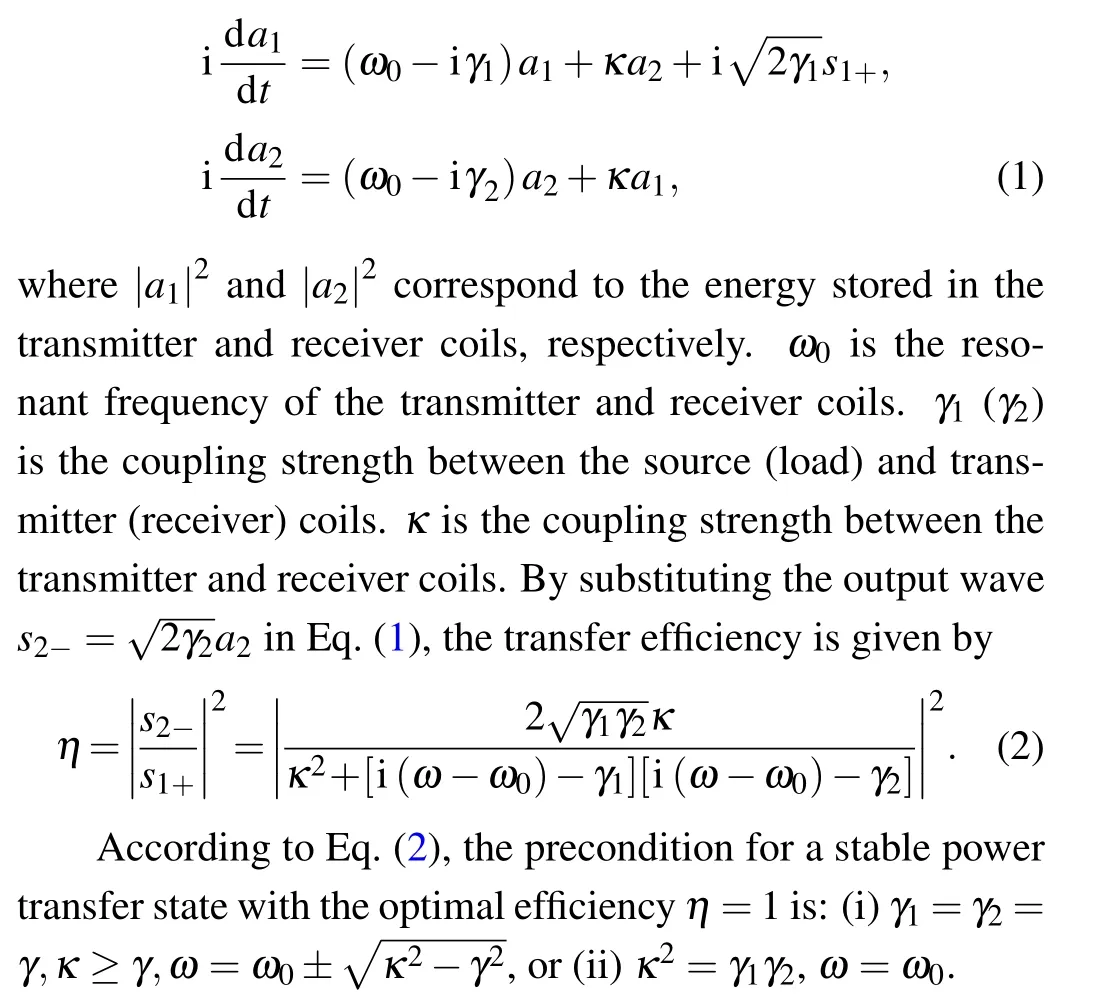

Fig.1. Scheme of a standard magnetic resonance WPT system. Transmitter and receiver coils are resonant coils. Source and load coils are non-resonant coils. γ1 (γ2) represents the coupling strength between source (load) and transmitter(receiver)coils. κ denotes the coupling strength between transmitter and receiver coils.

Let us start with a standard magnetic resonance WPT system of four-coil configuration. It is composed of the two resonant coils (i.e., transmitter and receiver coils) and two nonresonant coils(i.e., source and load coils), which is shown in Fig.1. When a continuous harmonic waves1+=S1+e-iωtat a real frequencyωis fed into the WPT system, the coupledmode equations for the system are presented as[19]H11=ω0+iγ1,H22=ω0-iγ2,andH12=H21=κ. Comparing Eq. (3) with the Schr¨odinger equation, one can find thatHcan be regarded as the effective Hamiltonian of the system.It is worth noting that the coefficient ofa1has changed from-iγ1in Eq.(1)to iγ1in Eq.(3)under the zero-reflection condition. In this case, the resonator modea1has an effect gainγ1, which comes from the external environment (the incident waves) instead of the actual gain material. Whenγ1=γ2is satisfied,His invariant under the joint action of the parity(H11↔H22,H12↔H21) and time reversal (i→-i) operators. Therefore, the traditional resonance WPT systems with symmetric configuration can be treated as a second-order PT symmetric system under zero-reflection condition.[23]
By solving|H-ωI|=0(whereIis an identical matrix),eigenfrequencies of the effective Hamiltonian in Eq.(4)can be obtained as

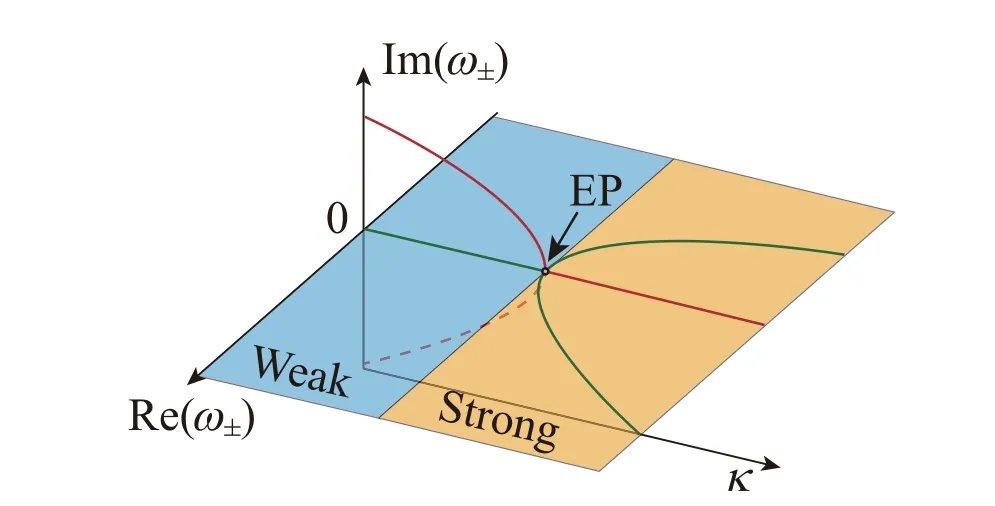
Fig. 2. Eigenfrequencies of resonant two-coil WPT systems with ideal PT symmetry(γ1=γ2).
Analyzing the eigenfrequencies of the effective Hamiltonian could reveal the physics of PT symmetry in WPT system.For the standard symmetric configuration (γ1=γ2=γ), the WPT system meets the requirement of an ideal second-order PT symmetry. In Fig. 2, the transition of the PT symmetry from exact PT phase to PT broken phase is labeled by the gradient color from orange to blue. The exact PT symmetric phase of the second-order system corresponds to the strongly coupled region of the WPT system (κ>γ), whose eigenfrequencies are purely real.[24,25]If the WPT system works at a pure real eigenfrequency, the optimal efficiency transfer can be achieved. However,these eigenfrequencies are very sensitive to the change of the coupling strengthκ, which directly depends on the coupling distance between the transmitter and receiver coils. Especially,when the transfer distance is small,the coherent effect is dominant in this strong coupling region,which leads to the working frequency splitting. But when the transfer distance is large,the WPT system corresponds to the weak coupling region (broken phase) of the non-Hermitian physical model, thus the transfer efficiency decreases rapidly as the transfer distance increases. Therefore, non-Hermitian physics can clearly explain the experimental results of the current resonance WPT systems.[26]Moreover,non-Hermitian physics can also be used to solve some key difficulties of previous designs. From Fig. 2, one can see that when the transmission distance changes,the pure real eigenvalues of the effective Hamiltonian in the non-Hermitian system will change.In order to achieve good transmission,the working frequency of the resonant WPT system needs to change accordingly.[19]Recently,Assawaworraritet al.[19]and Zhouet al.[3]have proposed a nonlinear PT-symmetric system,which automatically tracks the real eigenfrequency through the nonlinear saturable gain to ensure robust WPT. In addition, the PT symmetric broken phase region in Fig. 2(a) corresponds to the weakly coupled region of the WPT system (κ<γ). In this case,the imaginary part of the eigenfrequencies increases sharply with the coupling distance, which leads to the instability of the WPT system, that is, the transfer efficiency will decrease drastically with the increase of the coupling distance. Therefore,the critical transfer distance of the WPT system is determined by the PT phase transition pointκ=γ(also known as the second-order EP) at which the two eigenfrequencies collapse. Although the WPT system can operate under EP with fixed frequency, such a scheme would be extremely difficult in practical implementation due to the intrinsic sensitivity of EP.[18]
3. Stable and efficient WPT system based on PT symmetry
3.1. Two-coil WPT system based on non-ideal secondorder PT symmetry
In order to solve the problems of frequency splitting in the PT symmetric phase and the sensitivity of the EP point,a valuable question naturally arises: is it possible to find a fixed real eigenfrequency in the PT symmetric broken phase to achieve stable energy transmission? In addition, this scheme can be used to improve the transfer distance. As introduced in the above section, the transfer distance of resonance WPT in the PT symmetric broken phase could also be extended beyond the critical transfer distance determined by EP (κ=γ).For a non-ideal PT-symmetry (γ1/=γ2) WPT system withκ<κc=(γ1+γ2)/2,the imaginary part of the eigenfrequency is split into two branches, and one of them will pass through the real frequency axis when the relationshipκ2=γ1γ2is met,as shown in Fig. 3. Although there is no a whole purely real branch in the phase diagram of non-ideal PT symmetry, this critical relationship could ensure a real eigenfrequencyω0of the system. It should be point out that this solution cannot be found in the previous non-Hermitian system without gain except for the caseκ=0.
Under the circumstance of non-ideal PT-symmetry,Eq.(5)can be rewritten as

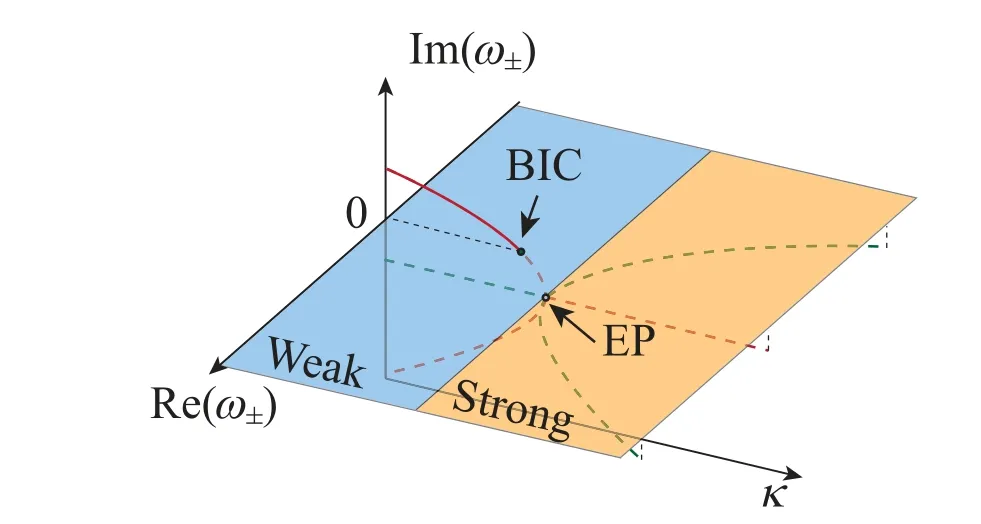
Fig.3. Eigenfrequencies of resonant two-coil WPT systems with non-ideal PT symmetry(γ1/=γ2).
3.2. Three-coil WPT system based on third-order PT symmetry
From Fig. 3 in Subsection 3.1, we can see that the real eigenfrequency in the non-ideal PT symmetry system corresponds to a point in the parameter space of PT phase diagram.In order to maintain a stable power transfer, people need to adjustγ2according to the coupling strengthκ. In this section,we will introduce a stable and efficient WPT based on the third-order PT symmetry of non-Hermitian system, in which the working frequency(real eigenfrequency)does not depend on the coupling strength. At present, it has been proved that the three-coil system with the insertion structure of a relay coil,[30-34]metamaterials[35-39]or metsurfaces[40-43]between the transmitter and receiver coils can improve the transmission distance compared with WPT system with two coils. Similar to treating the resonant two-coil system as a second-order PT symmetric system, one can also deal with a three-coil WPT system using the third-order PT symmetry.[44]As shown in Fig.4(a),the system’s effective Hamiltonian is

Here,κ12(κ23)is the coupling strength between the transmitter(relay)and relay(receiver)coils. When the intrinsic loss Γ(due to absorption or radiation)of the resonant coil is negligible andκ12=κ23=κ,the ideal third-order PT symmetry can be established. For example,Sakhdariet al.tune the values of the two coupling strengths equally by rotating the transmitter coil with a feedback algorithm.[45]By solving the characteristic equation|ωI-H′|=0,the eigenfrequencies are obtained as follows:

Theoretical and experimental results show that, at the fixed frequency, the efficiency stability of the third-order PT symmetric WPT system is significantly superior to that of the second-order PT symmetry, as shown in Fig. 4(c). This three-coil system is further extended to WPT with miniaturized receivers as an example,which shows stable transfer efficiency with a wide range of axial transfer distance and lateral misalignment.[40]Besides, the idle (in idle state without receiver terminals) power loss of this three-coil WPT system is also very low [see Fig. 4(d)], benefiting wireless charging intermittently. Considering utilizing higher-order(N>4)PT symmetry for WPT system, we can predict that the oddorder (N= 2m+1,mis a positive integer) resonant coils will show more stable transfer performance than that of evenorder (N= 2m) resonant coils because there is a couplingindependent entirely real eigenfrequency.
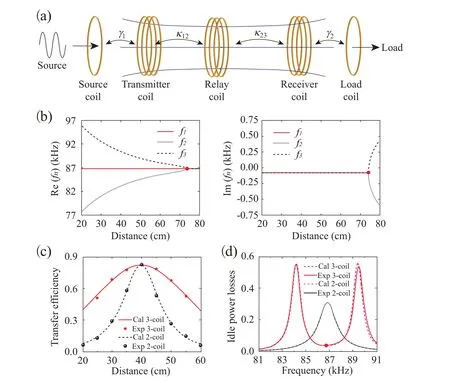
Fig.4.(a)Schemes of three-coil WPT system with third-order PT symmetry.(b)The real(left)and imaginary(right)eigenfrequencies of third-order PT symmetric systems. (c)Transfer efficiency versus distance in three-coil(red)and two-coil(black)WPT systems at fixed operating frequency.(d)Idle power losses versus frequency in three-coil(red)and two-coil(black)WPT systems.[44]
4. Non-Hermitian topological dimer chain for long-range robust WPT
With the development of WPT devices, the efficient long-range and robust WPT is highly desirable but also challenging.[46-49]Recently, the possibility of obtaining photonic topological modes that are robust against perturbations by mimicking the topological properties of solid state system,has brought a profound impact on optical sciences.[50,51]In particular, topological non-Hermitian systems provide an effective avenue for studying the intriguing properties of topological structures involving PT symmetry and developing new wave functional devices.[52]For example, using the EP of a non-Hermitian dimer chain, a new sensor that is sensitive to perturbation of on-site frequency at the end of the structure and yet topologically protected from internal perturbation of site-to-site couplings is realized.[53]In this section, we introduce the topological dimer chain with effective PT symmetry,which is composed of the topological edge modes(TEMs)and topological interface modes (TIMs), can be used to the long-range WPT.Especially,this topological WPT inherits the physical properties of topological modes and has good electromagnetic compatibility because it is immune to impurities and perturbations.
In 2018, Jianget al.firstly proposed that the nontrivial dimer chain will provide a suitable platform for the study of robust WPT in the RF regime.[54]The photonic topological dimer chain is inspired by the basic topological Su-Schrieffer-Heeger (SSH) model in condensed-matter physics.[55]Specially, based on the dimer chain composed of split-ring-resonators, the robustness of edge states,[54]topological invariant,[56]and the coupling between two SSH chains[57]have been demonstrated in recent years. The topological dimer chain on the long-range WPT with immunity to disturbance is of great significance in science and technology.Very recently,the physical mechanism of the effective second order PT system with TEMs in the dimer chain is analyzed and corresponding experiments are carried out to verify the long-range WPT.[58-60]Moreover, in order to solve the special technical problems of standby power loss and frequency tracking, Ref. [59] uncovered that an optimized topological WPT system with effective third-order PT symmetry, which is constructed by using one TIM and two TEMs, as shown in Fig. 5(a). The measured reflection spectra of the topological dimer chain with effective third-order PT symmetry under working and standby states are shown in Figs. 5(b) and 5(d),respectively. It should be noted that the reflection is not zero due to the influence of intrinsic loss. Nevertheless, the maximum value of transmission efficiency still corresponds to the real eigenvalue calculated theoretically. Figures 5(b) and 5(d)clearly show that the refection of the chain under working(standby)state is low(high)at the reference frequency,which means the standby power loss of the topological dimer chain with effective third-order PT symmetry is small.[59]Furthermore, in order to intuitively show the characteristics of low standby power loss in the topological WPT system with effective third-order PT symmetry,a source coil is placed at the left end of the chain and both ends of the chain are equipped with an LED lamp. One can see that two LED lamps will be lit up at the working state, as shown in Fig. 5(c). However,two LED lamps remain dark at the reference frequency for the standby state, as shown in Fig.5(e). Therefore, the small standby power loss of the topological dimer chain with effective third-order PT symmetry is demonstrated in Figs.5(c)and 5(d). Although TEMs and TIMs can be used for robust WPT with topological protection and can be immune to purities and perturbations,once the topological edge is totally broken,the topology WPT will be destroyed. In this case,the topological WPT is disappearing.
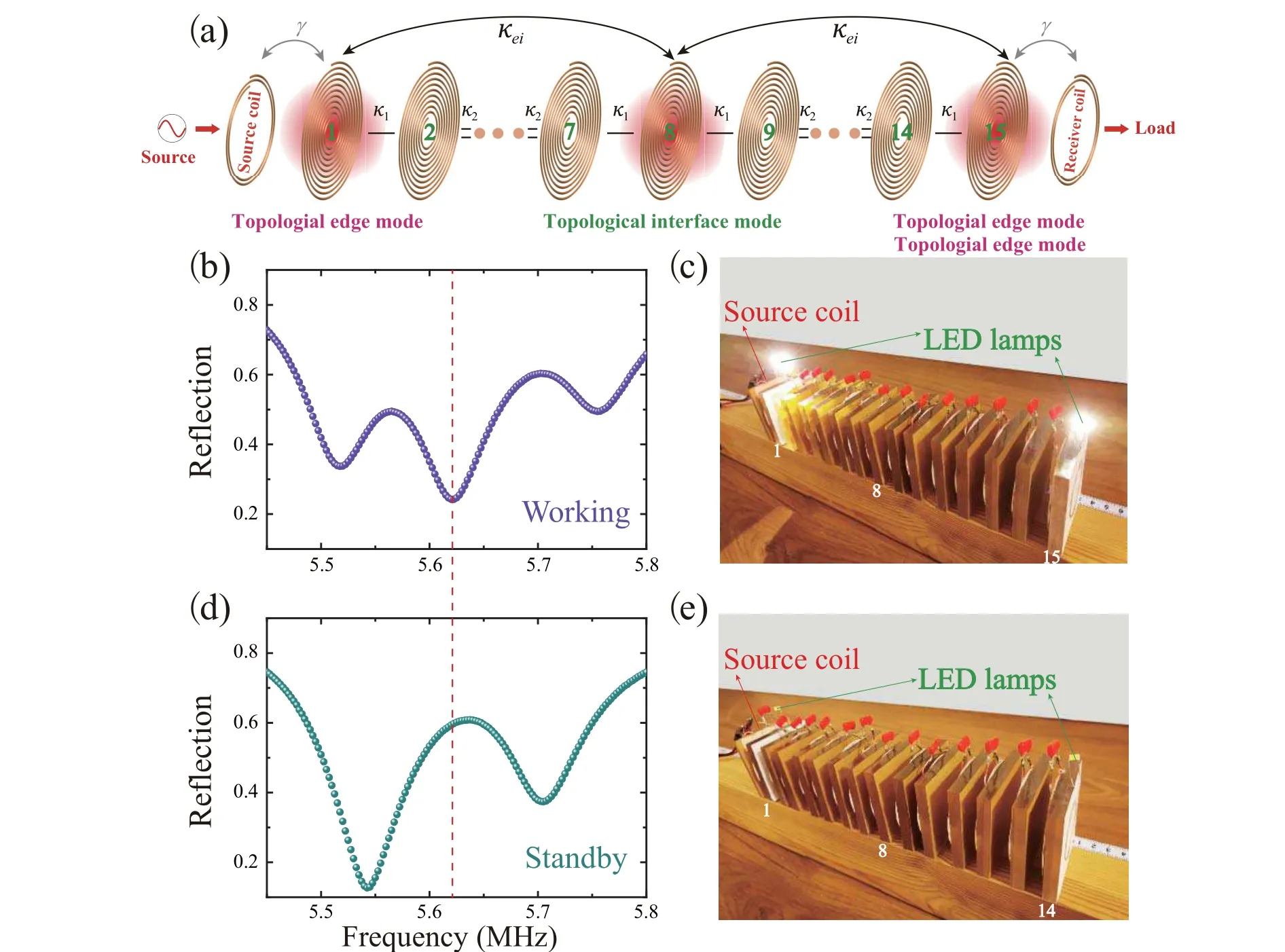
Fig.5. (a)Scheme of a multi-coil WPT system based on the effective third-order PT symmetry in a composite topological dimer chain,which is formed by the interaction of the three topological modes, including two TEMs at two ends of the chain and one TIM at the center of the chain.(b) Measured reflection spectrum of the topological dimer chain with effective third-order PT symmetry. (c) Experimental demonstration of the topological WPT of topological dimer chain with effective third-order PT symmetry by lighting two LED lamps at two ends of the chain. (d),(e)Similar to(b),(c),but for the standby state of the topological WPT with third-order PT symmetry.[59]
Overall,this WPT technology has many advantages in the field of long-range WPT: (1) There is low idle power loss,which can avoid the risk of burning the circuit due to excessive no-load power, thus greatly increasing safety and stability of the WPT system. (2) Stable and efficient transfer can always be realized at a fixed working frequency, which promotes practicability of WPT system. (3) This topological WPT system is realized by TEMs and TIMs,which has topological protection and is insensitive to internal perturbations and structural errors. The rise of topological photonics provides a powerful tool for near-field robust control of WPT.In addition to the properties of robustness and long-range, the robust directional WPT has been demonstrated using asymmetric topological edge states.[61,62]Especially, the realization of actively tuned TEMs in the topological quasiperiodic chain will open up a new avenue in the dynamical control of robust long-range WPT.[62]Although the current topological WPT schemes are mainly based on one-dimensional systems,the concept of topological manipulation can be consulted for higher dimensional system and related WPT devices. Therefore,the investigation in the topological dimer chain provides insightful guidance to exploring the exciting applications associated with topological transport in WPT regime.
5. Summary and outlook
This paper reviews some advances in stable and efficient WPT based on non-Hermitian physics, including using the bound states in the continuum of the two-coil WPT system with non-ideal second-order PT symmetry and resorting to the three-coil WPT system with third-order PT symmetry. Moreover, the robust long-range WPT with topological protection is also introduced combing the topological photonics and non-Hermitian physics. In a word,non-Hermitian physics not only provides new perspective to understand the abundant and interesting phenomena in the advanced resonance WPT,but also pave the ways for solving some key difficulties of previous designs.
The WPT system with high-order PT symmetry can significantly enhance the transfer distance. However, due to the use of more resonant coils, the WPT device has a large size.Considering how to introduce the synthetic dimensions[63-65]and build a multi-mode coupled high-order non-Hermitian system in a single coil is the direction of efforts to realize long-distance, efficient and miniaturized WPT devices in the future. In addition, the non-Hermitian system can also be established by asymmetric coupling rather than gain/loss engineering.[66,67]Specially, it is very interesting that all the eigenmodes are localized in the non-Hermitian system with asymmetric coupling, which are promising for efficient and robust WPT independent on the working frequency.
Acknowledgements
This research was supported by the National Key Research and Development Program of China (Grant No. 2016YFA0301101), the National Natural Science Foundation of China (Grant Nos. 91850206, 61621001, 2004284,11674247, and 11974261), Shanghai Science and Technology Committee, China (Grant Nos. 18JC1410900 and 18ZR1442900), the China Postdoctoral Science Foundation(Grant Nos. 2019TQ0232 and 2019M661605), the Shanghai Super Postdoctoral Incentive Program, and Fundamental Research Funds for the Central Universities,China.
杂志排行
Chinese Physics B的其它文章
- Superconductivity in octagraphene
- Soliton molecules and asymmetric solitons of the extended Lax equation via velocity resonance
- Theoretical study of(e,2e)triple differential cross sections of pyrimidine and tetrahydrofurfuryl alcohol molecules using multi-center distorted-wave method
- Protection of entanglement between two V-atoms in a multi-cavity coupling system
- Semi-quantum private comparison protocol of size relation with d-dimensional GHZ states
- Probing the magnetization switching with in-plane magnetic anisotropy through field-modified magnetoresistance measurement
